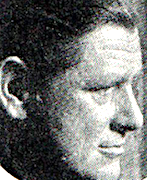
Richard Herbert Sheppard [commonly known as Richard Sheppard] was born in Bristol, Gloucestershire, England on 2 July 1910. He began his training as an architect as an architect at the at the Royal West of England Academy in Bristol. While at the Academy he contracted poliomyelitis and was forced to spend two years in hospital and lost the use of his legs. Undeterred, he moved to London and continued his training at the Architectural Association School. He was awarded the AA Diploma and was elected an Associate of the Royal Institute of British Architects (ARIBA).
While at the AA School he met Jean Shufflebotham (1911-1974) [subsequently Jean Sheppard]. They they married in 1938 and that year formed the architectural practice Richard Sheppard & Partners in London. During World War Two, both taught at the AA School which had been evacuated to Mount House in Hadley Common, Barnet.
Following the war, the couple returned to private practice in London.
In 1949 Geoffrey Robson (1918-1991) became a partner in the practice and in 1958 the name of the firm was changed to Richard Sheppard, Robson & Partners [later Sheppard Robson].
Richard Sheppard a member a member of the MARS. Modern Architectural Research Group. He was elected a an Associate of the Royal Academy (ARA) in 1966 and a Royal Academician (RA) in 1972. In 1981 he was knighted for his services to architecture. He died in Hertford on 18 December 1982.
Richard Sheppard & Partners and Richard Sheppard, Robson & Partners specialised in the design of educational buildings and subsequently designed some eighty schools. During the 1960s and 1970s the practice designed several university and college buildings including for Manchester Polytechnic and Imperial College, London, and at Loughborough (1961–66), Leicester, Brunel (1968–73), the City of London (1969–70). Their most admired building in this field is Churchill College, Cambridge, designed in 1959
Other works by the practice included shipyard buildings for Swan Hunter on the River Tyne (1950); a large shopping centre at Wood Green, north London; and office buildings in the City of London. Some twenty buildings designed by the practice received architectural awards.
Banham, Reyner. ‘Criticism’. Architectural Review vol. 136, September 1964 pp. 174-179 [The author compares and contrasts the architecture of St. Catherine’s College, Cambridge designed by Arne Jacobson with Churchill College, Cambridge designed by Richard Sheppard, Robson & Partners]
Booth, Philip and Taylor, Nicholas. Cambridge New Architecture. Foreword by Nilolaus Pevsner. London: Leonard Hill, 3rd edition,1970
Esher, Lionel. A Broken Wave: the Rebuilding of England, 1940–1980. London: Viking / Allen Lane, 1981
Jellicoe, Geoffrey. ‘Sheppard Robson and Partners’ in Contemporary Architects. Edited by Ann Lee Morgan and Colin Naylor. London and Chicago, Illinois: St. James Press, 2nd edition 1987 pp. 832-834
Jordan, Robert Furneaux. ‘Churchill Memorial College’. Architect and Building News vol. 216, 12 August 1959 pp. 2-4 [Part one of a two-part article on the competition to design Churchill College, Cambridge, won by Richard Sheppard, Robson & Partners]
Jordan, Robert Furneaux. ‘Churchill Memorial College’. Architect and Building News vol. 216, 19 August 1959 pp. 52-58 [Part two of a two-part article on the competition to design Churchill College, Cambridge, won by Richard Sheppard, Robson & Partners]
Mills, Edward David. The New Architecture in Britain 1946-1953. London: The Standard Catalogue Co., 1953 [Discusses a village school in Little Wymondley, Hertfordshire designed by Richard Sheppard, Jean Sheppard and Geoffrey Robson of Richard Sheppard & Partners in 1951-52 177-188]
Murray, Peter, et al. Sheppard Robson: Architects. London : Lund Humphries, 1983
Webb, Michael. Architecture in Britain Today. London: Country Life, 1969
Webb, Michael. ‘Massive simplicity beside the Cam’.